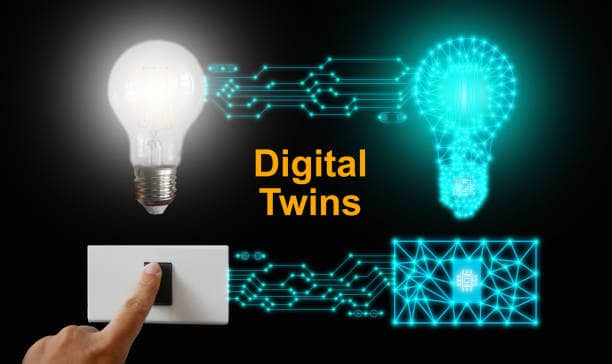You might be wondering what the difference is between digital twins, metaverse, and VR. Aren’t they all just different names for the same thing?
Technically, they are all related, but there are some key distinctions between them.

n this article, we’ll explore the differences and explain why each one is important. You’ll also get a glimpse of the exciting technological developments to expect in the next five years.
What Is Digital Twin Technology?
The term “digital twin” is used to describe a virtual replica of a physical object or system.
The technology is used to monitor and improve the performance of the physical object or system.
Digital twin technology has been around for a while, but it is becoming more and more popular due to advances in technology.
For example, the rise of virtual reality (VR) has made it possible to create more realistic digital twins.

In addition, the growth of the internet of things (IoT) has made it possible to create a digital twin of objects that were not previously possible, such as machines in factories.
As we all know, digital twins will play an important role in the future.
Majorly, it would be used to improve the performance of objects and systems and to help with decision-making.
SUBSCRIBE FOR A DIGITAL TWIN EXPERIENCE!
A Comprehensive Look at VR
When it comes to technology for Virtual Reality (VR), and AR, there are various subsidiaries; digital twins, metaverse. Let’s take a look at each one.
Digital twins are lifelike simulations of people, places, or things. They can be used for a variety of purposes, such as training and design.

For example, imagine being able to “try on” a new outfit without ever having to leave your house. That’s the kind of convenience digital twins offer.
Metaverse technology takes the concept of the digital twin a step further by allowing people to interact with each other in virtual environments. This could be used for social networking, education, or training.
Imagine being able to attend a business meeting from the comfort of your own home or taking a course from the world’s top professors without ever having to leave your couch.
Virtual reality is the most commonly known type of VR technology. It immerses users in an artificial environment that replaces their current surroundings.
This technology is often used for gaming and entertainment purposes, but it has many other potential applications as well. For example, it could be used to help people who are struggling with social anxiety or depression.
Understanding the Different Versions Of VR
To best understand how digital twins, metaverse, and virtual reality will work together in 2023, it’s important to first understand the differences between them.
Digital twins are created when two or more objects are virtually connected in a real-time 3D environment. This can be used to monitor physical objects or processes, like a jet engine or the production of a car.
Metaverse is an online world that is made up of various virtual places, each with its economy and social structures. It’s a bit like Second Life, but on a much larger scale.
Virtual reality is a completely immersive experience in which users can interact with digital environments and objects.
Each of these technologies has its unique benefits and applications. For example, digital twins can be used to improve safety and efficiency by allowing engineers to test products before they’re built.
Metaverse can be used to create social experiences that wouldn’t be possible in the real world. And virtual reality can be used for training and education, or just for pure entertainment.
What VR Innovations To Expect in 2023?

We are in an exciting moment of technological innovation when it comes to data-driven digital twins, metaverse, and virtual reality.
From the creation of realistic, interactive 3D models to the ability to store and analyze vast amounts of data in real-time, all three platforms are paving the way for new, dynamic applications.
In 2023, we will witness further technological advancements in each of these platforms.
For example, we can expect more sophisticated sensors to be introduced into digital twins for improved data collection and analysis.
We may also see improved virtual reality headsets with wider field-of-view displays and the ability to track eye movements for more immersive experiences.
Finally, artificial intelligence is likely going to become even more engrained within these platforms as it helps facilitate more accurate analysis and insights.
Amazon, Apple And Google Among The Frontliners
Deciding between Amazon, Google, and Apple tech when it comes to digital twins, metaverse, and virtual reality technology can be difficult. Each of these companies offers different technologies and innovations that you may want to invest in.
Amazon tech offers the Amazon Sumerian platform for developing virtual reality (VR), augmented reality (AR), and 3D applications.
With Amazon Sumerian, you can quickly and easily create 3D scenes, add elements such as lights, sounds, and animations, and create interactive experiences without any programming knowledge.
On the other hand, Google has created the Poly API for creating 3D scenes using a combination of the gaming engine Unity and VR.
The API also allows developers to customize their 3D experiences with materials from YouTube or other 3D objects from Google’s library.
Apple is working on its own AR/VR technology known as ARKit which lets developers create AR applications for iOS devices like iPhones and iPads.
The technology allows developers to combine real-world objects with virtual objects for an enhanced experience.
Overall, deciding between these three rival companies depends on your needs—consider what features you want in your app or product before investing in any technology from these companies.
Conclusion
In the next five years, the lines between digital twins, metaverse, and virtual reality technology will continue to blur. The three technologies will increasingly overlap and converge, with digital twins serving as the foundation for both the metaverse and virtual reality.
This will result in a more immersive and realistic experience for users, with a wide range of applications in business, education, healthcare, and beyond.






3 Comments